Belkin F5D7011A Wireless PCMCIA Card User Manual P74488 F5D7011 man indd
Belkin International, Inc. Wireless PCMCIA Card P74488 F5D7011 man indd
Belkin >
Contents
- 1. Doc
- 2. Users Manual Part 1 Revised
- 3. Users Manual Part 2 Revised
Users Manual Part 1 Revised

F5D7011
High-Speed Mode
Wireless G Notebook
Network Card
Connect your laptop computer to
a FASTER wireless network
User Manual

1 Introduction. . . . . . . . . . . . . . . . . . . . . . . . . . . . . . . . . . . . . . . . . . . . . . 1
Advantages of a Wireless Network . . . . . . . . . . . . . . . . . . . . . . . . . 1
Placement of your Wireless Networking Hardware for
Optimal Performance. . . . . . . . . . . . . . . . . . . . . . . . . . . . . . . . . . . . 2
2 Overview . . . . . . . . . . . . . . . . . . . . . . . . . . . . . . . . . . . . . . . . . . . . . . . . 5
Product Features . . . . . . . . . . . . . . . . . . . . . . . . . . . . . . . . . . . . . . . 5
Applications and Advantages . . . . . . . . . . . . . . . . . . . . . . . . . . . . . 6
Product Specifications. . . . . . . . . . . . . . . . . . . . . . . . . . . . . . . . . . . 6
System Requirements . . . . . . . . . . . . . . . . . . . . . . . . . . . . . . . . . . 7
Package Contents . . . . . . . . . . . . . . . . . . . . . . . . . . . . . . . . . . . . . 7
3 Installing and Setting Up the Card . . . . . . . . . . . . . . . . . . . . . . . . . . . 8
Step 1: Install the Software . . . . . . . . . . . . . . . . . . . . . . . . . . . . . . . 8
Step 2: Plug the Card in an Available CardBus
Slot of your Laptop. . . . . . . . . . . . . . . . . . . . . . . . . . . . . . . 9
Step 3: Let Windows Finish the Installation . . . . . . . . . . . . . . . . . 10
4 Using the Belkin Wireless LAN Utility. . . . . . . . . . . . . . . . . . . . . . . 12
Setting Wireless Network Preferences . . . . . . . . . . . . . . . . . . . . . 13
Securing your Wi-Fi Network . . . . . . . . . . . . . . . . . . . . . . . . . . . . 16
Monitoring the Status of your Network Connection. . . . . . . . . . . 28
Monitoring Data Transfer . . . . . . . . . . . . . . . . . . . . . . . . . . . . . . . . 30
Finding Available Networks in your Area . . . . . . . . . . . . . . . . . . . 31
Performing Diagnostic Tests on your Connection . . . . . . . . . . . . 32
5 Troubleshooting . . . . . . . . . . . . . . . . . . . . . . . . . . . . . . . . . . . . . . . . . 34
6 Information . . . . . . . . . . . . . . . . . . . . . . . . . . . . . . . . . . . . . . . . . . . . . 43
Table of Contents

Introduction
section
1
2
3
4
5
6
7
8
9
10
Thank you for purchasing the Belkin High-Speed Mode Wireless G
Notebook Network Card (the Card). Now you can take advantage
of this great new technology without using cables. The High-Speed
Mode Wireless G Notebook Network Card works like a conventional
network card, but without the wires. The easy installation and setup
will have you networking wirelessly in minutes. Please be sure to read
through this User Manual completely, and pay special attention to the
section entitled “Placement of your Wireless Networking Hardware for
Optimal Performance”.
Advantages of a wireless network
• Mobility – you no longer need a dedicated “computer room”—
you can work on a networked laptop or desktop computer
anywhere within your wireless range
• Easy installation – Belkin Easy Installation Wizards make
setup simple
• Flexibility – set up and access printers, computers, and other
networking devices from anywhere in your home
• Easy Expansion – the wide range of Belkin networking products
let you expand your network to include devices such as printers
and gaming consoles
• No cabling required – you can spare the expense and hassle of
retrofitting Ethernet cabling throughout the home or office
• Widespread industry acceptance – choose from a wide range
of interoperable networking products
1

32
Introduction
32
Introduction
Placement of your Wireless Networking Hardware for
Optimal Performance
Your wireless connection will be stronger the closer your computer
is to your Wireless Router (or Access Point). Typical indoor operating
range for your wireless devices is between 100 and 200 feet. In the
same way, your wireless connection and performance will degrade
somewhat as the distance between your Wireless Router (or Access
Point) connected devices increases. This may or may not be
noticeable to you. As you move further from your Wireless Router
(or Access Point), connection speed may decrease. Factors that can
weaken signals simply by getting in the way of your network’s radio
waves are metal appliances or obstructions, and walls.
If you have concerns about your network’s performance that might
be related to range or obstruction factors, try moving the computer
to a position between five and ten feet from the Wireless Router (or
Access Point), in order to see if distance is the problem. If difficulties
persist even at close range, please contact Belkin Technical Support.
Note: While some of the items listed below can affect network
performance, they will not prohibit your wireless network from
functioning; if you are concerned that your network is not operating
at its maximum effectiveness, this checklist may help.
1. Placement of your Wireless Router or Access Point
Place your Wireless Router (or Access Point), the central connection
point of your network, as close as possible to the center of your
wireless network devices.
To achieve the best wireless network coverage for your “wireless
clients,” (i.e. computers enabled by Belkin Wireless Notebook
Network Cards, Wireless Desktop Network Cards, and Wireless
USB Adapters):
• Ensure that your Wireless Router (or Access Point) antennas
are parallel to each other, and are positioned vertically (toward
the ceiling). If your Wireless Router (or Access Point) itself is
positioned vertically, point the antennas as much as possible in
an upward direction.
• In multistory homes, place the Wireless Router (or Access Point) on a
floor that is as close to the center of the home as possible. This may
mean placing the Wireless Router (or Access Point) on an upper floor.
• Try not to place the Wireless Router (or Access Point) near a
cordless 2.4GHz phone.

3
Introduction
Introduction
3
Introduction
section
1
2
3
4
5
6
7
8
9
10
2. Avoid Obstacles and Interference
Avoid placing your Wireless Router (or Access Point) near devices
that may emit radio “noise”, such as microwave ovens. Other objects
that can inhibit Wireless communication can include:
• Refrigerators
• Washers and/or dryers
• Metal cabinets
• Large aquariums
• Metallic-based UV tinted windows
If your wireless signal seems weak in some spots, make sure that
objects such as these are not blocking the signal’s path between your
computers and Wireless Router (or Access Point).
3. Cordless Phone Placement
If the performance of your wireless network is impaired after
attending to the above issues, and you have your cordless phone:
• Try moving cordless phones away from Wireless Router or
Access Point and your wireless-enabled computers
• Unplug and remove the battery from any cordless phone
that operate on the 2.4GHz band (check manufacturers
information). If this fixes the problem, your phone may
be interfering.
• If your phone supports channel selection, change the
channel on the phone to the furthest channel from your
wireless network, as possible. For example, change the
phone to channel 1 and move your Wireless Router (or
Access Point) to channel 11. See your phone’s user manual
for detailed instructions.
• If necessary, consider switching to a 900MHz or 5GHz
cordless phone.
4. Choose the “quietest” channel for your wireless network
In locations where homes or offices are close together, such as
apartment buildings or office complexes, there may be wireless
networks nearby that can conflict with yours. Use the Site Survey
capabilities of your Wireless LAN Utility to locate any other wireless

54 54
Introduction
networks, and move your Wireless Router (or Access Point) and
computers to a channel as far away from other networks as possible.
Experiment with more than one of the available channels, in order to
find the clearest connection and avoid interference from neighboring
cordless phones or other wireless devices.
Use the detailed Site Survey and wireless channel information
included in your User Guide for more information.
5. Secure connections, VPNs, and AOL
Secure connections are connections that typically require a user
name and password, and are used where security is important.
Secure connections include:
• Virtual Private Network (VPN) connections, often used to connect
remotely to an office network
• The “Bring Your Own Access” program from America Online
(AOL), which lets you use AOL through broadband provided by
another cable or DSL service
• Most on-line banking websites
• Many commercial websites which require a username and
password to access your account
Secure connections can be interrupted by a computer’s power
management setting, which causes it to “go to sleep.” The simplest
solution to avoid this is to simply reconnect by re-running the VPN or
AOL software, or by re-logging into the secure web site.
A second alternative is to change your computer’s power management
settings so it does not go to sleep; however, this may not be appropriate
for portable computers. To change your power management setting
under Windows, see the “Power Options” item in the Control Panel.
If you continue to have difficulty with Secure Connection, VPNs and
AOL please review steps 1-4 above to be sure you have addressed
these issues.
These guidelines should allow you to cover the maximum possible area
with your Wireless Router. Should you need to cover an even wider
area, we suggest Belkin’s Wireless Range Extender/Access Point.
For more information regarding our networking products, visit our
website at www.belkin.com/networking or call Belkin Technical Support.
Introduction

55
section
1
2
3
4
5
6
7
8
9
10
Introduction
Product Features
The Card complies with the IEEE 802.11g standard in order to
communicate with other 802.11g-compliant wireless devices at
54Mbps or the faster 125 High-Speed Mode (HSM)*. The card
is compatible with all 802.11g devices as well as other 802.11b
products at 11Mbps. 802.11g products operate on the same 2.4GHz
frequency band as 802.11b Wi-Fi products.
• 2.4GHz ISM (Industrial, Science, and Medical) band operation
• Integrated easy-to-use Wireless Configuration Utility
• CardBus interface, for operation in virtually any notebook computer
• WPA, 64-bit WEP (Wired Equivalent Privacy), or 128-bit encryption
• Wireless access to networked resources
• Support for both Infrastructure and Ad-Hoc (peer-to-peer)
networking modes
• Easy installation and use
• Internal antenna
• LED power and network link indicators
Overview
*When operating in High-Speed Mode, this Wi-Fi device may achieve an actual throughput
of up to or greater than 34.1 Mbps, which is the equivalent throughput of a system
following 802.11g protocol and operating at a signaling rate of 125 Mbps. Actual throughput
will vary depending on environmental, operational and other factors.

76
76
Applications and Advantages
• Wireless roaming with a laptop around the home or office
Offers the freedom of networking without cables
• Connection rates of up to 54Mbps or 125Mbps* using HSM
provides immediate, higher-speed wireless connectivity at home,
work, and hot spot locations without compromising the use of
existing 802.11b products
• Compatibility with 802.11b products
802.11g wireless LAN solutions are backward-compatible with
existing Wi-Fi (IEEE 802.11b) products and with other products
that display the 54g mark and/or 125HSM mark
• Difficult-to-wire environments
Enables networking in buildings with solid or finished walls, or
open areas where wiring is difficult to install
• Frequently changing environments
Adapts easily in offices or environments that frequently rearrange
or change locations
• Temporary LANs for special projects or peak time
Sets up temporary networks, (such as at trade shows, exhibitions
and constructions sites), on a short-term basis; also companies
who need additional workstations for a peak activity period.
• SOHO (Small Office/Home Office) networking needs
Provides the easy and quick, small network installation SOHO
users need.
Product Specifications
Host Interface 32-bit Cardbus
Power Consumption Tx/Rx peak 550/350mA @
3.3 VDC(max)
Operating Temperature 32 –185 degrees F (0 –85 degrees C)
Storage Temperature -40 –194 degrees F (-40 – 90 degrees C)
Humidity (Max. 95% (non-condensing)
Typical Operating Range Up to 200 feet (Wireless performance
may vary depending on the
networking environment)
Overview
*When operating in High-Speed Mode, this Wi-Fi device may achieve an actual throughput
of up to or greater than 34.1 Mbps, which is the equivalent throughput of a system
following 802.11g protocol and operating at a signaling rate of 125 Mbps. Actual throughput
will vary depending on environmental, operational and other factors.
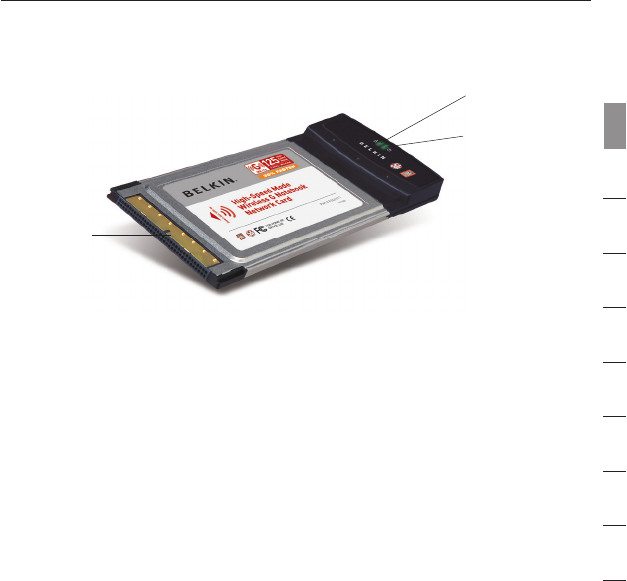
7
7
section
1
2
3
4
5
6
7
8
9
10
Overview
(a) Power LED
Lights up when the Card receives power
(b) Link LED
Lights up when the Card links to a wireless network
Slowly flashes when not linked to a wireless network
(c) Card Connector
Part of the Card that fits into your computer’s
CardBus slot
System Requirements
• PC-compatible laptop with one available CardBus slot
• Windows® 98SE, Me, 2000, XP
Package Contents
• High-Speed Mode Wireless G Notebook Network Card
• Quick Installation Guide
• Installation Software CD
• User Manual
(a)
(b)
(c)
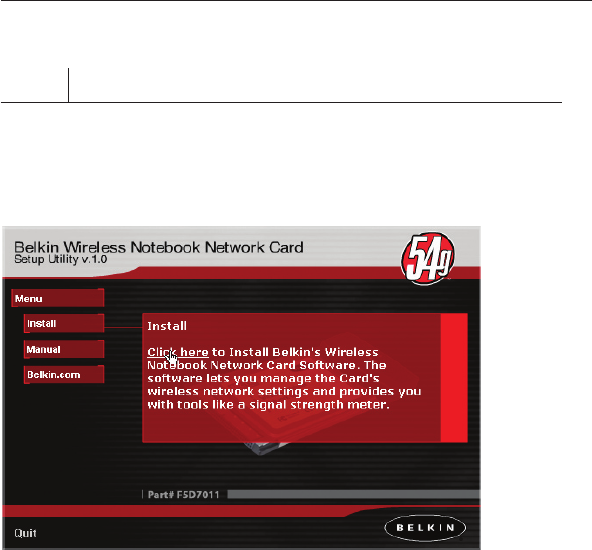
98
98
Step 1 Install the Software
WARNING: INSTALL THE SOFTWARE BEFORE INSERTING THE CARD.
1.1 Insert the Installation Software CD into your CD-ROM drive.
1. 2 The Belkin Setup Utility will automatically appear.
Note: If the Setup Utility screen does not appear within 20 seconds,
open your CD-ROM drive by double-clicking on the “My Computer”
icon and insert the CD. Double-click on the CD-ROM drive that the
installation CD has been placed in to start the installation. Then,
double-click on the folder named “Files”. Next, double-click on the
icon named “setup.exe”.
1.3 In the menu window, drag your mouse over the “Install” button
then select “Click here” to start the software installation program.
Installing and Setting up the Card
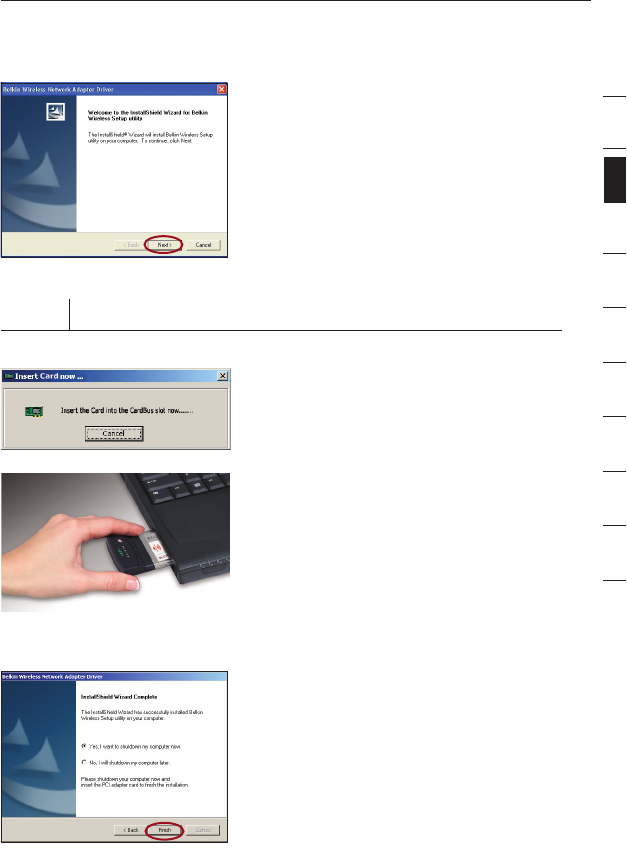
9
9
section
1
2
3
4
5
6
7
8
9
10
Installing and Setting up the Card
Step 2 Plug the Card in an Available CardBus Slot of your Laptop
2.1 During the install process, you
will be prompted to insert your
Card. Insert the Card, label side
UP, into your computer’s CardBus
slot firmly until it stops. The power
light on the top will turn on when
it is inserted properly.
Note: If your system did not
prompt you to insert your Card
after the installation is completed,
please do so now.
2.2 After the installation is complete,
click “Finish”.
1.4 The installer will now start. Click
“Next” and follow the
on-screen instructions.
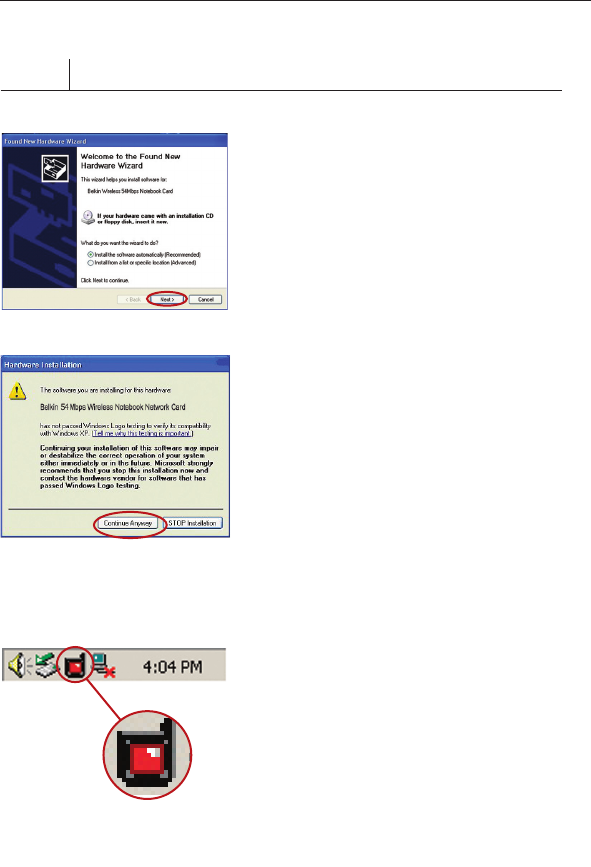
1110
1110
Step 3 Let Windows Finish the Installation
3.1 Depending on the version of
Windows you are using, you
might see the “Found New
Hardware Wizard” screen.
Select “Install the software
automatically (Recommended)”
and click “Next”.
3.2 You might also see a screen
similar to this one. This DOES
NOT mean there is a problem.
Select “Continue Anyway” and
follow the on-screen instructions.
3.3 If you are using Windows 98SE
or Me, you will be asked to restart
your computer. If you
are using Windows 2000 or
XP, click “Finish” to finish the
installation process.
3.4 When the installation is
complete, a small Signal
Indicator icon in your system
tray (bottom right corner of
most screens) will appear.
Double-click the Signal
Indicator icon to bring up the
Wireless Network” screen.
Installing and Setting up the Card
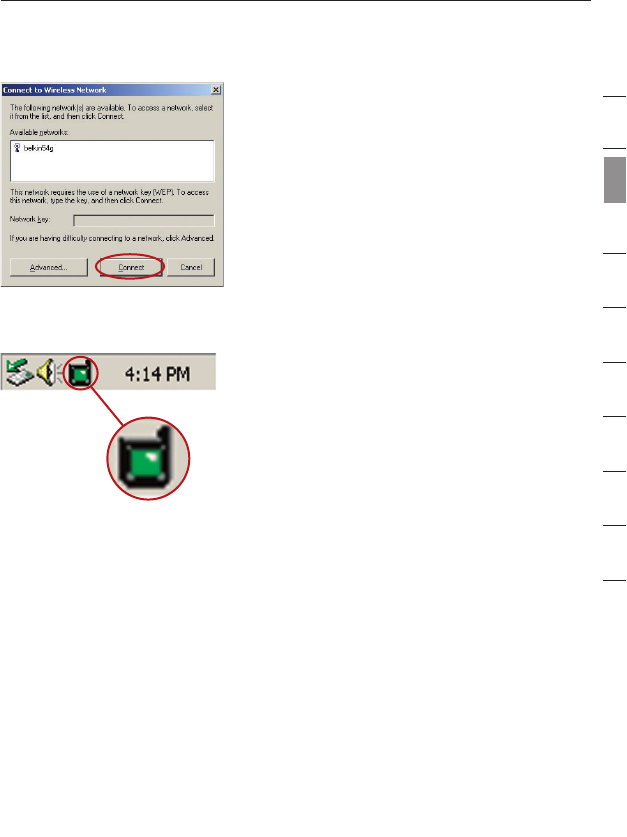
11
11
section
1
2
3
4
5
6
7
8
9
10
Installing and Setting up the Card
3.5 Select the network you want
to connect to under “Available
networks” and click “Connect”.
3.6 The Signal Indicator icon in
your system tray should now
turn green (yellow if the signal
is weak.)
Installation is now complete!
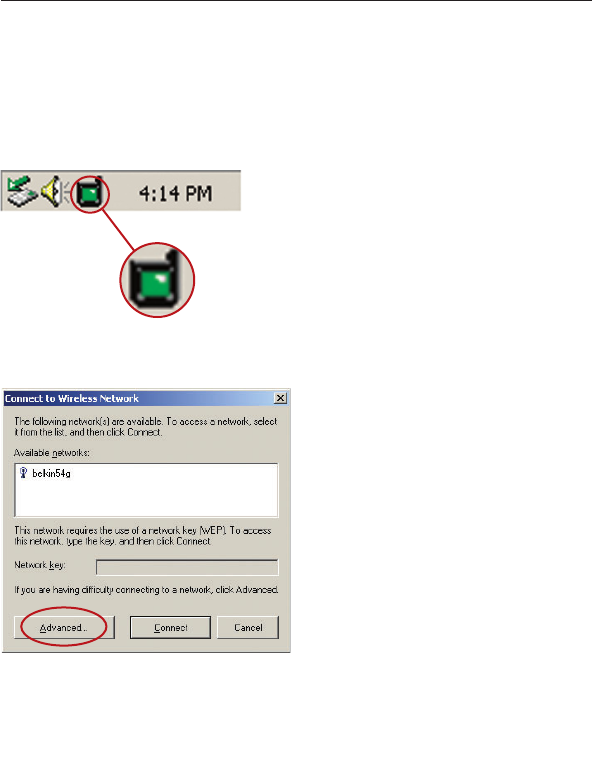
1312
1312
How to Access the Belkin Wireless LAN Utility
Double-click the Signal Indicator icon to bring up the “Wireless
Network” screen.
The following screen will appear:
Next, click on the “Advanced” button to enable the Belkin Wireless
LAN Utility. This utility will allow you to view and configure the
wireless settings of your card.
Using the Belkin Wireless LAN Utility
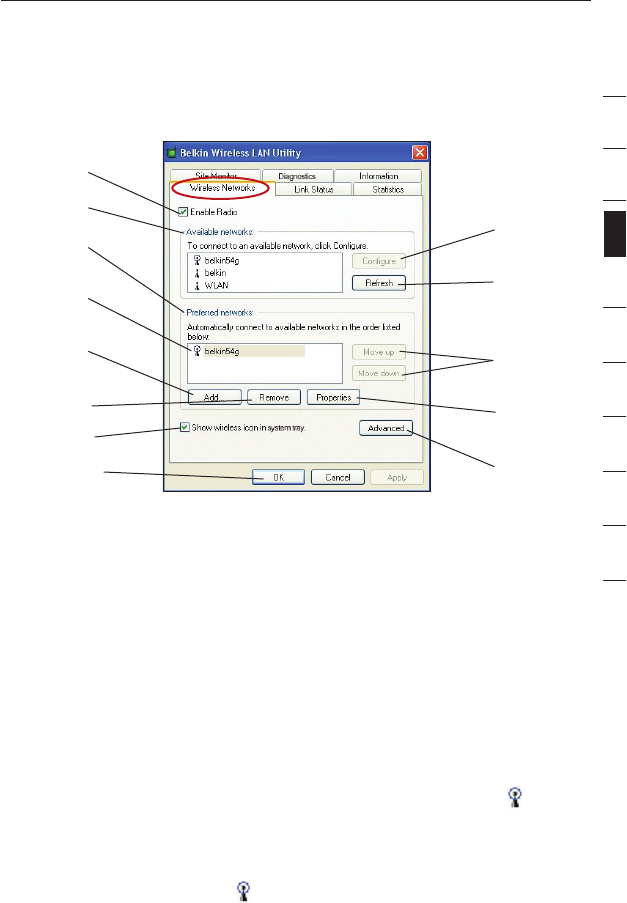
13
13
section
1
2
3
4
5
6
7
8
9
10
Using the Belkin Wireless LAN Utility
Setting Wireless Network Preferences
Click on the “Wireless Networks” tab.
(a) Enable Radio
Use this option to turn your wireless network radio ON or OFF. You
may want to turn the radio off while in airplanes or to conserve the
battery life of your mobile computer. When the radio is disabled, the
power LED on your Card will turn off and the system tray wireless
network icon will be depicted with an “X”.
(b) Available Networks
This displays a list of wireless networks in your area. If you don’t see
a name in the box, click on the “Refresh” (j) button to rescan for any
available networks. To connect to a network, select a network name in
the Available Networks list box and click the “Configure” (i) button
Click “OK” (m) in the “Wireless Network Properties” box to add the
network name to the “Preferred Networks” (c) list. Wait up to one
minute for the network connection to be made. Your computer is
connected to the selected network when you see a blue bubble (d)
on top of the icon for that network.
(c) Preferred Networks
Displays a list of the networks that you have previously configured.
The one with the blue bubble (d) is the network you are currently
connected to. You may rank the networks by selecting the network
(a)
(b)
(c)
(d)
(e)
(f)
(g)
(i)
(j)
(k)
(h)
(l)
(m)
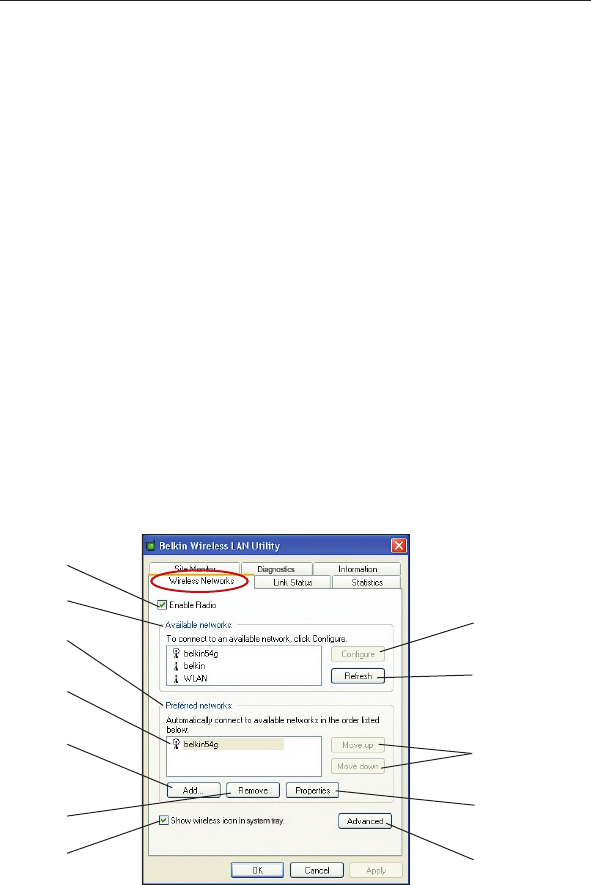
1514
1514
name in the “Preferred Networks” list then clicking on the “Move Up”
and “Move Down” (k) buttons. Networks appearing higher on the list
will be preferred over networks listed lower on the list. If a preferred
network is unavailable, the Card will attempt to connect to the next
available network on the list.
(e, f) Add, Remove
You may “Add” (e) and “Remove” (f) networks from the Preferred
Networks list by using these buttons.
(g) System Tray Icon
Check this box so that the wireless icon appears on your system tray.
(h) Properties
To change the properties and WEP (security) settings of a network,
select a network from the Preferred Networks (c) then click on the
“Properties” (h) button.
(l) Advanced
Allows you to select the type of networks you want to connect to.
When the “Advanced” (l) button is checked, the screen on the next
page will appear.
(a)
(b)
(c)
(d)
(e)
(f)
(g)
(i)
(j)
(k)
(h)
(l)
Using the Belkin Wireless LAN Utility
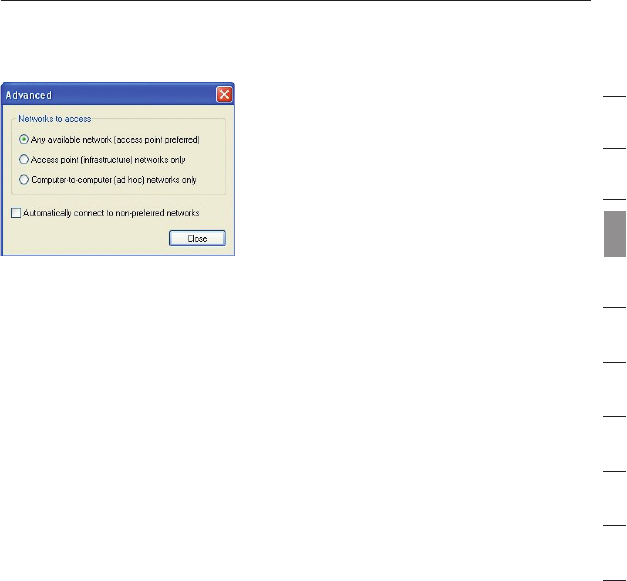
15
15
1
2
3
4
5
6
7
8
9
10
section
Any Available Network (access point preferred)
When this option is selected, the Card will attempt to connect to any
available network in the area. Access point networks will be preferred
over ad-hoc networks. Access Point (Infrastructure) networks only
mode allows you to connect to the Internet by accessing the wireless
router or wireless access point or your network
Access Point (Infrastructure) Networks Only
When this option is selected, the Card will attempt to connect to
any available wireless router or access point in the area. Ad-Hoc
networks will be excluded from the list of available networks when
this option is selected.
Computer-to-Computer (Ad-Hoc) Networks Only
When this option is selected, the Card will attempt to connect to any
available computer in the area that’s also configured to be used in
Ad-Hoc mode. The wireless router or access point will be excluded
from the list of available networks when this option is selected.
Using the Belkin Wireless LAN Utility

1716
1716
Securing your Wi-Fi® Network
Here are a few different ways to maximize the security of your wireless
network and protect your data from unwanted intrusion. This section
is intended for the home, home office, and small office user. At the
time of publication, three encryption methods are available.
Encryption Methods:
WEP (Wired Equivalent Privacy)
WEP (Wired Equivalent Privacy) is a common protocol that adds
security to all Wi-Fi-compliant wireless products. WEP gives wireless
networks the equivalent level of privacy protection as a comparable
wired network.
64-Bit WEP
64-bit WEP was first introduced with 64-bit encryption, which
includes a key length of 40 bits plus 24 additional bits of system-
generated data (64 bits total). Some hardware manufacturers refer
to 64-bit as 40-bit encryption. Shortly after the technology was
introduced, researchers found that 64-bit encryption was too easy
to decode.
Using the Belkin Wireless LAN Utility
Name 64-bit Wired
Equivalent Privacy
128-bit
Encryption
Wi-Fi
Protected
Access
Wi-Fi
Protected
Access
Acronym 64-bit WEP 128-bit WEP WPA-TKIP WPA-AES
Security Good Better Best Best
Features Static keys Static keys Dynamic key
encryption
and mutual
authentication
Dynamic key
encryption
and mutual
authentication
Encryption keys
based on RC4
algorithm (typically
40-bit keys)
Added security
over 64-bit
WEP using a
key length of
104 bits, plus
24 additional
bits of system-
generated data
TKIP (temporal
key integrity
protocol)
added so
that keys are
rotated and
encryption is
strengthened
AES
(Advanced
Encryption
Standard)
does not
cause any
throughput
loss.

17
17
1
2
3
4
5
6
7
8
9
10
section
128-Bit Encryption
As a result of 64-bit WEP’s potential security weaknesses, a more
secure method of 128-bit encryption was developed. 128-bit
encryption includes a key length of 104 bits plus 24 additional bits of
system-generated data (128 bits total). Some hardware manufacturers
refer to 128-bit as 104-bit encryption.
Most of the new wireless equipment in the market today supports
both 64-bit WEP and 128-bit WEP encryption, but you might have
older equipment that only supports 64-bit WEP. All Belkin wireless
products will support both 64-bit WEP and 128-bit encryption.
Encryption Keys
After selecting either the 64-bit WEP or 128-bit encryption mode, it is
critical that you generate an encryption key. If the encryption key is
not consistent throughout the entire wireless network, your wireless
networking devices will be unable to communicate with one another.
You can enter your key by typing in the hex key. A hex (hexadecimal)
key is a mixture of numbers and letters from A–F and 0–9. For 64-bit
WEP, you need to enter 10 hex keys. For 128-bit WEP, you need to
enter 26 hex keys.
For instance:
AF 0F 4B C3 D4 = 64-bit WEP key
C3 03 0F AF 0F 4B B2 C3 D4 4B C3 D4 E7 = 128-bit key
Write down the hex WEP key from your wireless router or access
point and enter it manually into the hex WEP key table in your Card’s
configuration screen.
Using the Belkin Wireless LAN Utility

1918
1918
WPA (Wi-Fi Protected Access)
WPA (Wi-Fi Protected Access) is a new Wi-Fi standard that improves
upon the security features of WEP. To use WPA security, the drivers
and software of your wireless equipment must be upgraded to support
it. These updates will be found on your wireless vendor’s website.
There are two types of WPA security: WPA-PSK (no server), and WPA
(with radius server).
WPA-PSK (no server) uses what is known as a pre-shared key as
the network key. A network key is a password that is between 8 and
63 characters long. It can be a combination of letters, numbers,
or characters. Each client uses the same network key to access
the network. Typically, this is the mode that will be used in a home
environment.
WPA (with radius server) is a system where a radius server
distributes the network key to the clients automatically. This is
typically found in a business environment.
For a list of Belkin wireless products that support WPA, please visit
our website at www.belkin.com/networking.
Most Wireless products ship with security turned off. So once you
have your network working, you may need to activate WEP or WPA
and make sure all your wireless devices are sharing the same
network key.
Using the Belkin Wireless LAN Utility
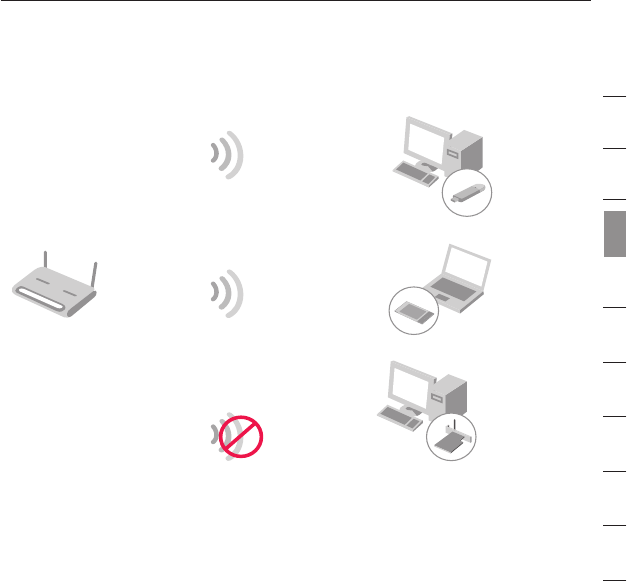
19
19
1
2
3
4
5
6
7
8
9
10
section
The following diagram shows the effect of not having the correct
network key throughout your network.
The Card cannot access the network because it uses a different network key than the one
configured on the wireless router.
Setting Up your Belkin Wireless Router or Access Point
to Use Security
To start using security, you need to first enable WEP or WPA for
your wireless router or access point. For Belkin Wireless Routers (or
Access Points), these security features can be configured by using
the web-based interface. See your wireless router (or access point)
manual for directions on how to access the management interface.
Changing the Wireless Security Settings
The Belkin Wireless G Router and Belkin G Range Extender/Access
Point are equipped with the latest WPA security feature. They also
support the legacy WEP security standard. By default, wireless
security is disabled.
To enable security, you will need to determine which standard you
want to use. To access the security settings, click “Security” on the
wireless section using the web-based interface. (See your wireless
router or access point manual for directions on how to access the
security settings.)
Wireless G Router
Wireless G Notebook
Network Card
Wireless G Desktop
Network Card
Wireless G USB
Network Adapterz
Network key=
WRONG Password
Network key=
MyPassword
Network key=
MyPassword
Network key=
MyPassword
Using the Belkin Wireless LAN Utility
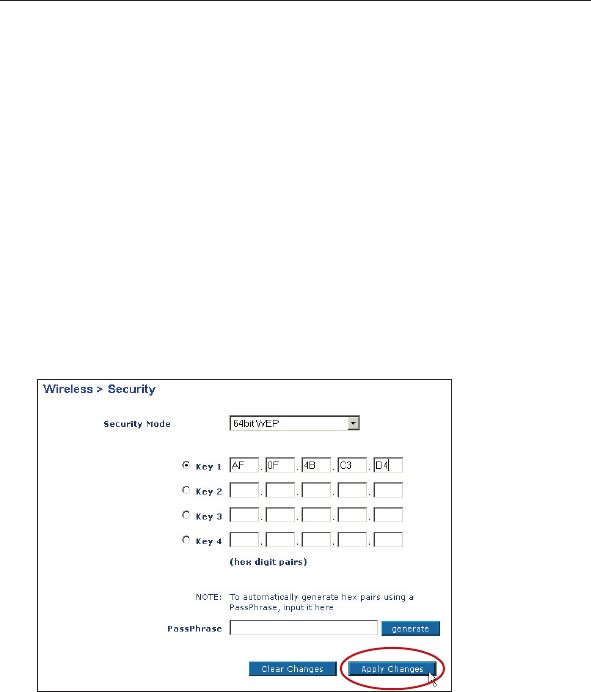
2120
2120
WEP Setup
64-Bit WEP Encryption
1. Select “64-bit WEP” from the drop-down menu.
2. After selecting your WEP encryption mode, you can enter your
key by typing in the hex key manually, or you can type in a
passphrase in the “Passphrase” field and click “Generate” to
create a key.
A hex (hexadecimal) key is a mixture of numbers and letters from
A–F and 0–9. For 64-bit WEP, you need to enter 10 hex keys.
For instance:
AF 0F 4B C3 D4 = 64-bit WEP Key
3. Click “Apply Changes” to finish. Encryption in the wireless router
or access point is now set. Each of your computers on your
wireless network will now need to be configured with the same
security settings.
WARNING: If you are using a wireless client to turn on the security
settings in your wireless router or access point, you will temporarily
lose your wireless connection until you activate security on your
wireless client. Please record the key prior to applying changes in the
wireless router or access point. If you don’t remember the hex key,
your client will be locked out of the wireless router or access point.
Using the Belkin Wireless LAN Utility
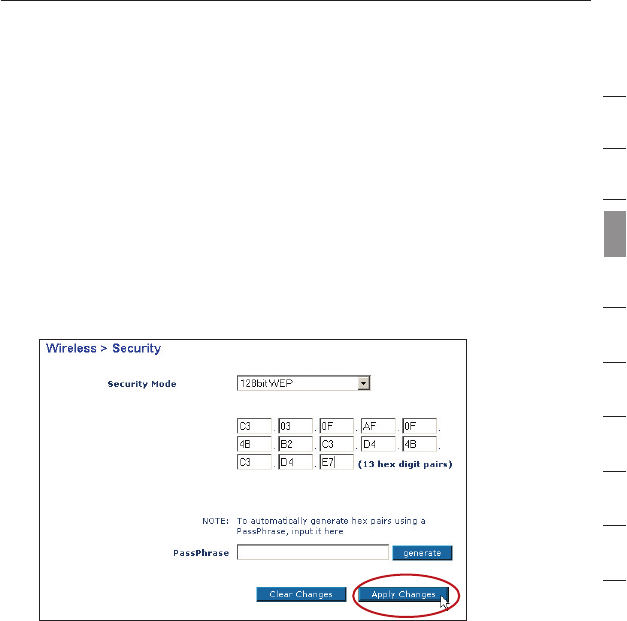
21
21
1
2
3
4
5
6
7
8
9
10
section
128-Bit WEP Encryption
1. Select “128-bit WEP” from the drop-down menu.
2. After selecting your WEP encryption mode, you can enter your
key manually by typing in the hex key manually, or you can type
in a passphrase in the “Passphrase” field and click “Generate” to
create a key.
A hex (hexadecimal) key is a mixture of numbers and letters from
A–F and 0–9. For 128-bit WEP, you need to enter 26 hex keys.
For instance:
C3 03 0F AF 0F 4B B2 C3 D4 4B C3 D4 E7 = 128-bit WEP key
3. Click “Apply Changes” to finish. Encryption in the wireless router
or access point is now set. Each of the computers on your
wireless network will now need to be configured with the same
security settings.
WARNING: If you are using a wireless client to turn on the security
settings in your wireless router or access point, you will temporariy
lose your wireless connection until you activate security on your
wireless client. Please record the key prior to applying changes in the
wireless router or access point. If you don’t remember the hex key,
your client will be locked out of the wireless router or access point.
Using the Belkin Wireless LAN Utility
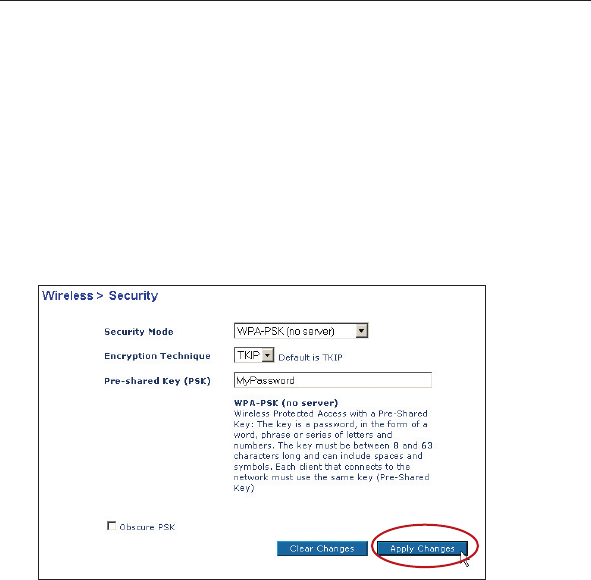
2322
2322
WPA-PSK (no server)
Choose this setting if your network does not use a radius server. WPA-PSK
(no server) is typically used in home and small office networking.
1. From the Security Mode drop-down menu, select “WPA-PSK
(no server)”.
2. Enter your network key. This can be from 8 to 63 characters and
can be letters, numbers, or symbols. This same key must be used
on all of the clients (network cards) that you want to include in
your wireless network.
3. Click “Apply Changes” to finish. You must now set all clients
(network cards) to match these settings.
Using the Belkin Wireless LAN Utility
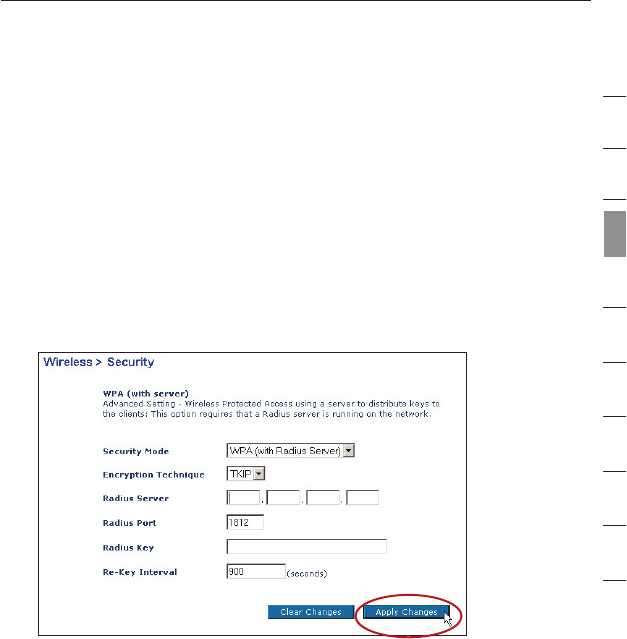
23
23
1
2
3
4
5
6
7
8
9
10
section
WPA (with server) Settings
Choose this setting if your network uses a radius server to distribute
keys to the clients (network cards). WPA (with server) is typically used
in business networks.
1. From the Security Mode drop-down menu, select “WPA (with
Radius Server)”.
2. Enter the IP address of the radius server into the “Radius
Server” fields.
3. Enter the radius key into the “Radius Key” field.
4. Enter the key interval. The key interval is how often the keys are
distributed (in packets).
5. Click “Apply Changes” to finish. You must now set all clients
(network cards) to match these settings.
IMPORTANT: You must now set all wireless network cards/
adapters to match these settings.
Using the Belkin Wireless LAN Utility

2524
2524
Configuring your Belkin Wireless G Notebook and Wireless G
Desktop Network Cards to Use Security
At this point, you should already have your wireless router or access
point set to use WPA or WEP. In order for you to gain wireless
connection, you will need to set your Wireless G Notebook and
Wireless G Desktop Network Cards to use the same security settings.
Connecting your Computer to a Wireless Router or Access Point that
requires a 64-Bit or 128-Bit WEP Key:
1. Double-click the Signal Indicator icon to bring up the
“Wireless Network” screen. The “Advanced” button will allow you
to view and configure more options of your Card.
2. Under the “Wireless Network” tab, select a network name from
the “Available networks” list and click “Configure”.
3. Under “Data Encryption” select “WEP”.
4. Ensure that the check box “The key is provided for me
automatically” at the bottom is unchecked. If you are using this
computer to connect to a corporate network, please consult your
network administrator if this box needs to be checked.
Using the Belkin Wireless LAN Utility
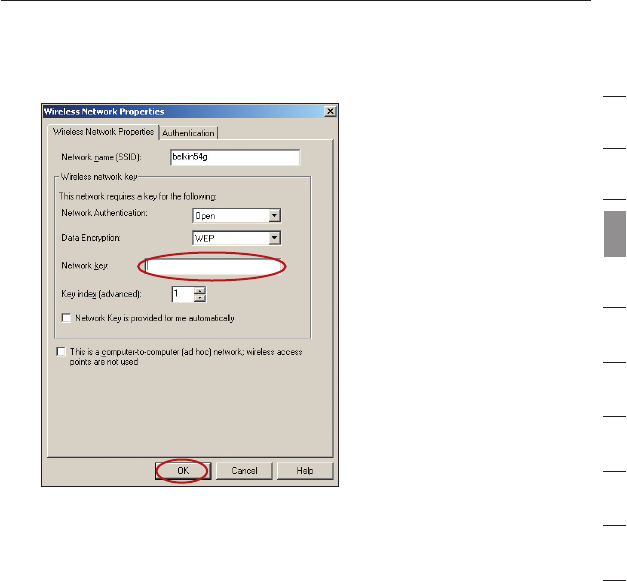
25
25
1
2
3
4
5
6
7
8
9
10
section
5. Type your WEP key in the “Network key” box.
Important: A WEP key is a mixture of numbers and letters from A–F
and 0–9. For 128-bit WEP, you need to enter 26 keys. For 64-bit WEP,
you need to enter 10 keys. This network key needs to match the key
you assign to your wireless router or access point.
6. Click “OK”, and then “Apply” to save the settings.
Using the Belkin Wireless LAN Utility
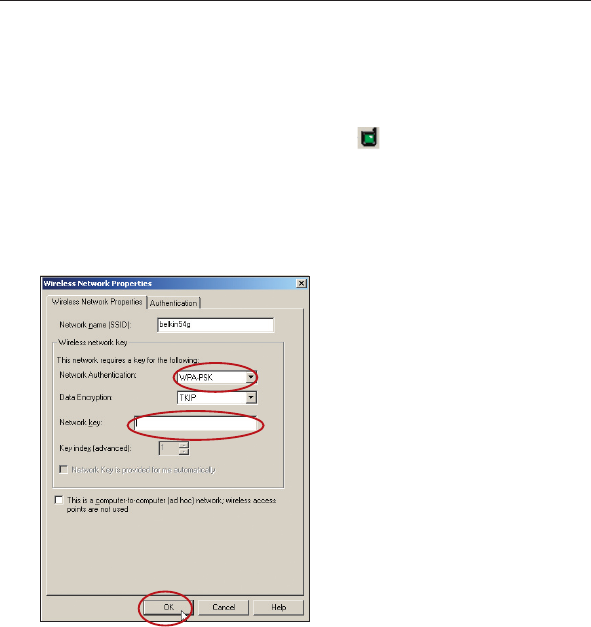
2726
2726
Connecting your Computer to a Wireless Router or Access Point that
uses WPA-PSK (no server)
1. Double-click the “Signal Indicator” icon to bring up the
“Wireless Network Properties” screen. The “Advanced” button will
allow you to view and configure more options of your Card.
2. Under the “Wireless Networks” tab, select a network name from
the “Available networks” list and click “Configure”. The following
screen will appear.
3. Under “Network Authentication” select “WPA-PSK”.
4. Type your WPA key in the “Network key” box.
Important: WPA-PSK is a combination of numbers and letters
from A–Z and 0–9. For WPA-PSK. The key must be between 8
and 63 characters long, and needs to match the key you assign
to your wireless router or access point.
5. Click “OK”, then “Apply” to save the settings.
Using the Belkin Wireless LAN Utility
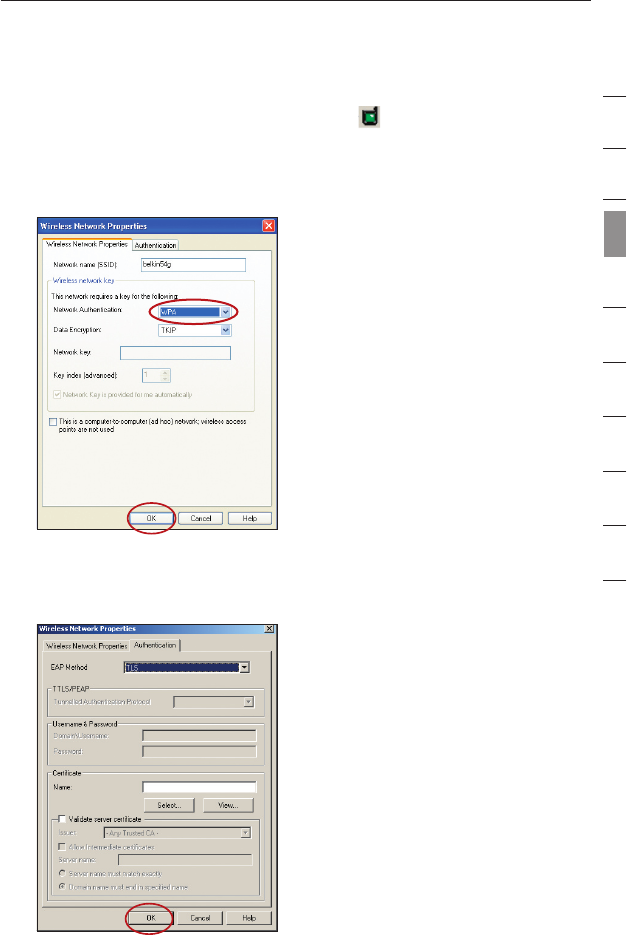
27
27
1
2
3
4
5
6
7
8
9
10
section
Using the Belkin Wireless LAN Utility
Connecting your Computer to a Wireless Router or Access Point that
uses WPA (with Radius Server)
1. Double-click the “Signal Indicator” icon to bring up the
“Wireless Network Properties” screen. The “Advanced” button
will allow you to view and configure more options of your Card.
2. Under the “Wireless
Networks” tab, select a
network name from the
“Available networks” list
and click “Configure”. The
screen to the left
will appear.
3. Under “Network
Authentication”
select “WPA”.
4. Under the
“Authentication” tab,
select the settings that
are indicated by your
network administrator.
5. Click “OK”, to save
the settings.
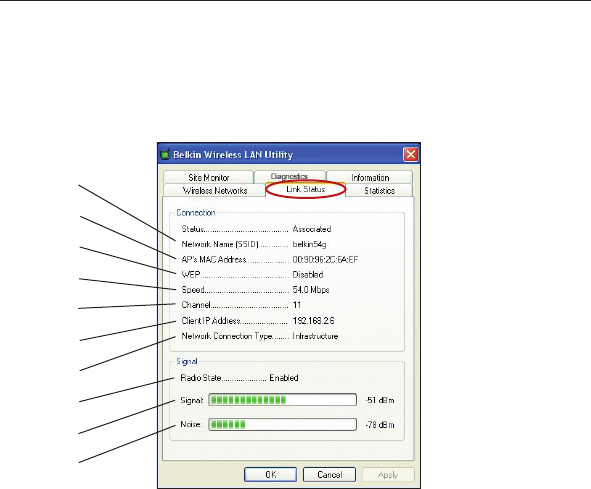
2928
2928
Using the Belkin Wireless LAN Utility
Monitoring the Status of your Network Connection
Click on the “Link Status” tab.
(a) Network Name (SSID)
The SSID is the wireless network name. This field shows the current
network name that you are connected to.
(b) AP’s MAC Address
Shows the MAC address of the wireless router or access point that
you are connected to.
(c) WEP
Shows whether the network you are associated with has WEP
encryption enabled or disabled.
(d) Speed
Displays the data rate of the current connection.
(e) Channel
Shows the current channel (1-11) you are using. When connected to a
wireless router or access point, the channel is set automatically. When
connected to another computer using Ad-Hoc mode, the channel can
be set manually. All computers using Ad-Hoc mode (computer-to-
computer) need to operate under the same channel.
(a)
(b)
(c)
(d)
(e)
(f)
(g)
(h)
(j)
(i)

29
29
1
2
3
4
5
6
7
8
9
10
section
Using the Belkin Wireless LAN Utility
(f) Client IP Address
Shows the IP address of the computer. The IP address is obtained
automatically by default. You may set the IP address manually through
Windows Networking Properties.
(g) Network Connection Type
Shows the current wireless mode the Card is operating in. There are
two operating modes: Infrastructure and Ad-Hoc. Infrastructure is the
most common mode to operate in. Infrastructure mode is used when
connecting your PC to a wireless router or a wireless access point.
Ad-Hoc mode is used to connect two or more computers together
without the use of a wireless router or an access point.
(h) Radio State
Shows whether the radio of your wireless client is enabled or
disabled.
(i) Signal
Displays the wireless signal strength in decibels (dBm). The decibel
scale is negative, so smaller absolute values correspond to stronger
signals (i.e. -20 dBm is stronger than -80 dBm). The signal to noise
ratio (SNR) is the difference between the signal and the noise (e.g.
if the noise is -80 dBm and the signal is -20 dBm, the SNR is 60
dB); the larger the SNR, the better. In general, connections should
have an SNR greater than 20 dBm, or the user may experience poor
reliability and/or performance. If the signal is less than -50 dBm, the
user should consider repositioning their workstation Wireless Router
or Access Point, rotating the Wireless Router or Access Point’s
antennas, or Limiting their Transmission Rate (described on page 38
of the troubleshooting section of the manual), to ensure a reliable
wireless connection.
(j) Noise
Displays the intensity of the external noise, on this wireless channel,
in decibels (dBm). If the noise is greater than -70 dBm, the user
should consider changing the wireless channel used in their Wireless
Router or Access Point, to ensure a reliable wireless connection.
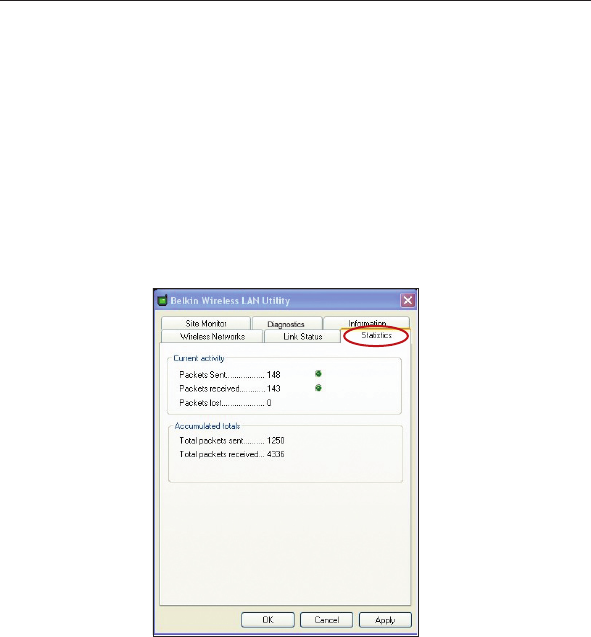
3130
3130
Using the Belkin Wireless LAN Utility
Monitoring Data Transfer
Click on the “Statistics” tab.
The Statistics tab shows you how much data has been sent and
received and if any errors occurred. This screen is mostly for
diagnostics. Note that the number of data packets lost is recorded. A
large number of lost data packets may indicate that there is a problem
or interference in your area. (See the Troubleshooting section for tips
on how to improve performance.)